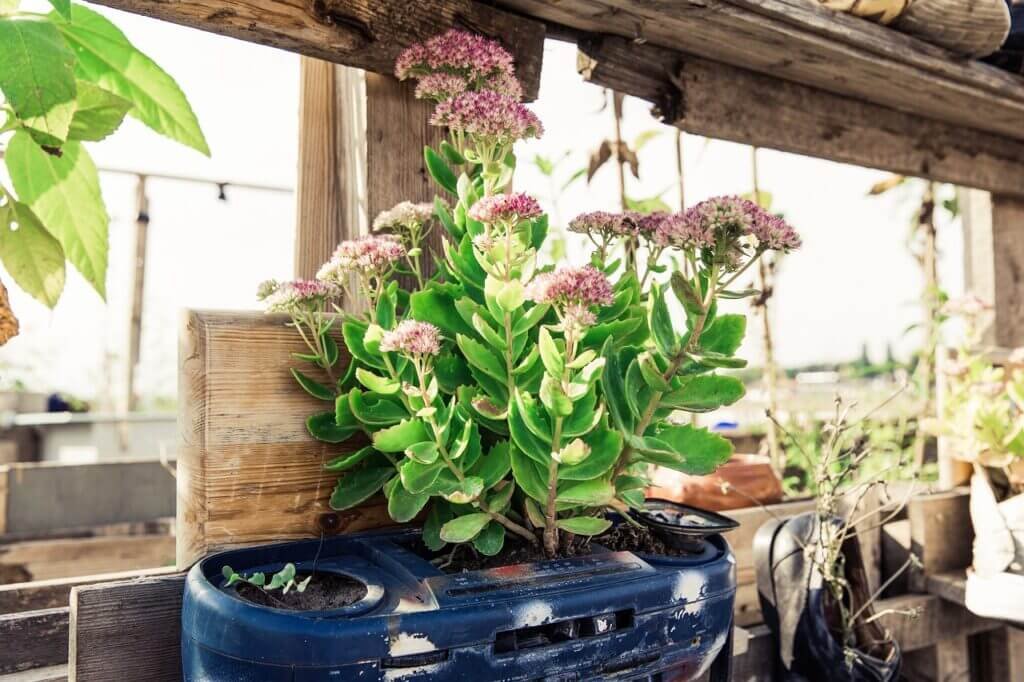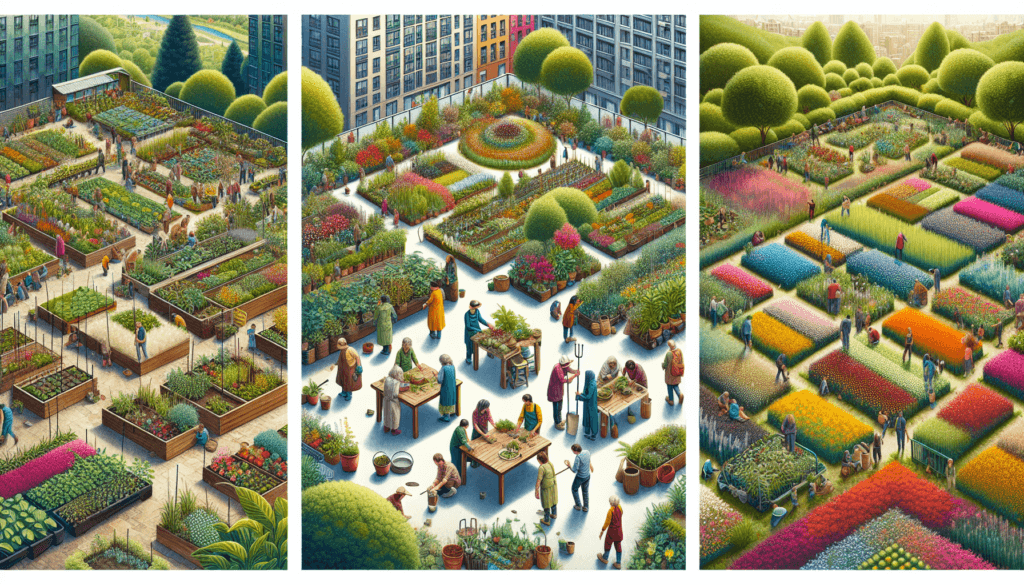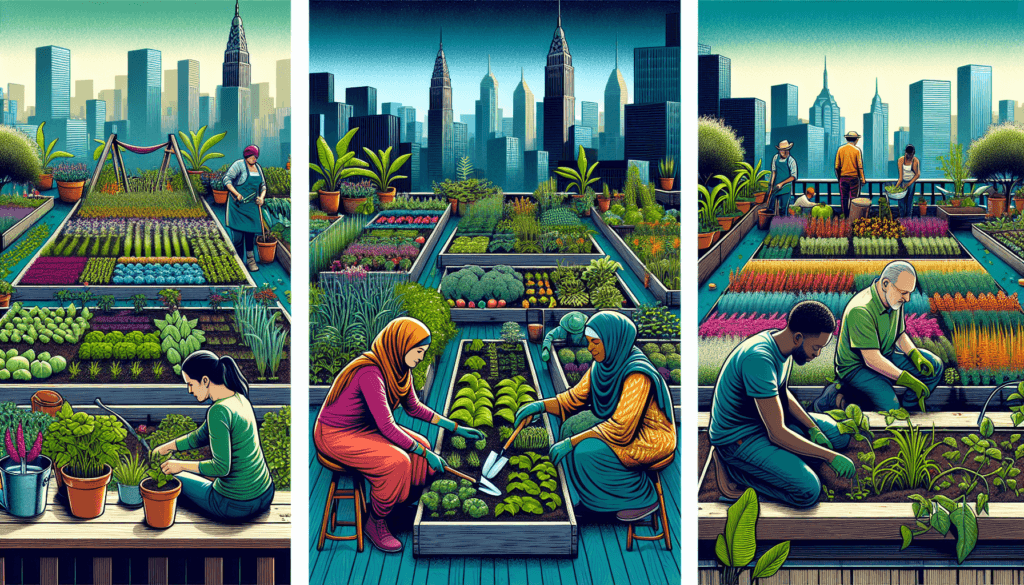If you’ve ever wondered about the different types of community gardens out there, you’re in the right place! In this article, we’ll explore three unique kinds of community gardens that you may not have known existed. From urban gardens sprouting on rooftop terraces to therapeutic gardens providing healing for both mind and body, we’ll take a closer look at the diverse ways communities are coming together to cultivate green spaces and foster a greater sense of belonging. So, grab your gardening gloves and join us as we uncover the magic behind these three kinds of community gardens.

Rooftop Gardens
Urban Rooftop Gardens
Urban rooftop gardens have become increasingly popular in densely populated cities. These gardens are created on the rooftops of buildings, utilizing the available space effectively. By transforming formerly unused areas into green havens, urban rooftop gardens provide numerous benefits. They not only beautify the cityscape but also help combat the heat island effect, improve air quality, and provide a peaceful retreat for people in bustling urban environments.
Suburban Rooftop Gardens
Suburban rooftop gardens offer a unique opportunity for homeowners to create their own personal oasis. These gardens can be created on the rooftops of houses, garages, or other structures on residential properties. Suburban rooftop gardens allow individuals to grow their favorite plants, flowers, and even vegetables. They provide a sense of privacy and can serve as a serene escape where you can relax, unwind, and reconnect with nature without having to leave the comfort of your own home.
Benefits of Rooftop Gardens
Rooftop gardens offer a multitude of benefits. Firstly, they help reduce the urban heat island effect, which occurs when cities absorb and retain heat due to extensive concrete and asphalt surfaces. By introducing vegetation and green spaces, rooftop gardens act as natural cooling systems, reducing the overall temperature of buildings and surrounding areas. Additionally, these gardens improve air quality by filtering pollutants and capturing carbon dioxide. Rooftop gardens also provide insulation, reducing energy consumption and lowering utility bills. Moreover, they can be a source of fresh produce, contribute to local food sustainability, and even serve as communal spaces for socializing and community events. Overall, rooftop gardens are a sustainable and innovative way to utilize urban and suburban spaces.
School Gardens
Educational School Gardens
Educational school gardens are a valuable resource that allows students to learn about the environment, biology, and sustainable practices. These gardens are often created in school compounds and serve as outdoor classrooms. Students are involved in every stage of the gardening process, from planting seeds to harvesting produce. By participating in hands-on activities, they gain practical knowledge and develop a deeper understanding of nature. Educational school gardens also promote a sense of responsibility, as students learn to care for and nurture plants, fostering a connection with the natural world.
Edible School Gardens
Edible school gardens not only provide a hands-on learning experience but also offer the opportunity to grow fresh and healthy food. These gardens can be integrated into the school’s nutrition curriculum, allowing students to understand the importance of healthy eating and the process from seed to plate. By engaging in activities such as composting and organic gardening, students develop a sense of environmental stewardship and develop lifelong healthy habits. Edible school gardens can also enhance food education programs, providing students with the practical skills necessary for cultivating and preparing nutritious meals.
Advantages of School Gardens
School gardens have numerous advantages beyond academic enrichment. They create a sense of community within the school, as students, teachers, and parents collaborate on garden projects. School gardens also serve as living laboratories for various subjects, including science, math, and art. Additionally, these gardens can improve student nutrition and introduce children to a wider variety of fruits and vegetables. By engaging in outdoor activities, students may experience reduced stress levels, increased physical activity, and improved mental well-being. Ultimately, school gardens cultivate a love for nature, foster environmental consciousness, and offer a holistic approach to education.
Therapeutic Gardens
Healing Gardens
Healing gardens, also known as restorative gardens or wellness gardens, are designed to promote healing and provide solace for patients, caregivers, and healthcare professionals. These gardens are typically found in hospitals, rehabilitation centers, and other healthcare facilities. Healing gardens incorporate various elements such as serene landscapes, sensory stimulation, and accessibility features. By immersing oneself in a healing garden, stress levels can be reduced, blood pressure can be lowered, and overall well-being can be improved. These gardens offer a peaceful retreat where one can find tranquility and find respite from the challenges of healthcare settings.
Rehabilitative Gardens
Rehabilitative gardens are specifically designed to aid in the recovery and rehabilitation process for individuals with physical or mental health conditions. These gardens often feature therapeutic elements such as wheelchair-accessible paths, raised garden beds, and sensory gardens. Rehabilitative gardens can provide opportunities for physical therapy, cognitive therapy, and social interactions. Gardening activities in these spaces can help improve motor skills, enhance cognitive abilities, and boost self-esteem. By engaging in gardening tasks, individuals can regain a sense of purpose, regain their independence, and restore their mental and physical well-being.
Positive Effects of Therapeutic Gardens
Therapeutic gardens have been shown to have numerous positive effects on individuals’ mental, emotional, and physical health. Time spent in these gardens has been linked to reduced stress, anxiety, and depression. The connection with nature has a calming effect on the mind, promoting a sense of relaxation and tranquility. Engaging in gardening activities can also provide a sense of accomplishment and boost self-esteem, especially for individuals undergoing rehabilitation. Furthermore, these gardens can foster social connections, allowing patients, caregivers, and healthcare professionals to come together in a supportive and healing environment. Overall, therapeutic gardens offer holistic care and play a crucial role in the well-being and recovery of individuals.
Kitchen Gardens
Culinary Herb Gardens
Culinary herb gardens are a popular choice for individuals who enjoy cooking and seek to have fresh herbs readily available. These gardens are typically located near the kitchen or in pots on the windowsill, making it convenient to access the herbs while preparing meals. By cultivating culinary herbs, you can enhance the flavors of your dishes, experiment with different flavors, and reduce reliance on store-bought herbs. Culinary herb gardens can include a variety of herbs such as basil, parsley, mint, and thyme, allowing you to add a touch of freshness and complexity to your culinary creations.
Vegetable Gardens
Vegetable gardens are an excellent way to grow your own organic produce, ensuring that your meals are fresh, nutritious, and free of harmful pesticides. Whether you have a small backyard or a larger space dedicated to gardening, you can cultivate a diverse range of vegetables to suit your tastes and preferences. From tomatoes and peppers to lettuce and carrots, the options are limitless. Vegetable gardens not only provide a sustainable food source but also offer the satisfaction of nurturing plants and harvesting the fruits of your labor. Gardening in this context allows you to connect with nature, appreciate the seasonal cycles, and gain a deeper understanding of where your food comes from.
Benefits of Kitchen Gardens
Kitchen gardens offer numerous benefits beyond the convenience of having fresh herbs and vegetables at your fingertips. By growing your own herbs and vegetables, you can reduce your ecological footprint, minimizing transportation-related emissions and packaging waste. Kitchen gardens also promote a healthier lifestyle by encouraging the consumption of fresh and nutrient-rich produce. Engaging in gardening activities can be a source of physical exercise and stress relief, benefiting both your body and mind. Furthermore, kitchen gardens allow you to experiment with different flavors and culinary techniques, sparking creativity in the kitchen and enhancing the overall dining experience.

Community Allotment Gardens
Individual Plots
Community allotment gardens, also known as community gardens or shared gardens, offer individuals the opportunity to have their own assigned gardening plot within a larger communal space. These individual plots are typically divided into smaller sections and allocated to community members. Each person can cultivate their preferred plants, flowers, or vegetables in their designated area. Individual plots provide a sense of ownership and allow community members to express their personal gardening preferences and creativity. It creates a unique space for individuals to connect with nature, engage in a rewarding hobby, and contribute to the overall beauty and vibrancy of the community.
Collective Gardening Spaces
In addition to individual plots, community allotment gardens often have designated collective gardening spaces. These shared areas are open to all community members and provide opportunities for collaboration, knowledge sharing, and communal gardening activities. Collective gardening spaces may include features such as flower beds, herb gardens, composting areas, and seating areas. They serve as gathering spaces where people can develop friendships, exchange gardening tips, and work together on projects that benefit the entire community. Collective gardening promotes a sense of community spirit and strengthens social bonds among diverse groups of individuals who come together with a shared passion for gardening.
Advantages of Allotment Gardens
Community allotment gardens offer numerous advantages for both individuals and communities as a whole. They provide an opportunity for individuals with limited access to land or resources to engage in gardening and grow their own produce. Allotment gardens foster a strong sense of community belonging and camaraderie, bringing people together from different backgrounds and fostering social connections. These gardens can also contribute to food security, as community members can share their harvests and reduce dependence on store-bought produce. Additionally, allotment gardens promote environmental sustainability by encouraging organic gardening practices, composting, and reducing food waste. Overall, they create a sense of pride, belonging, and cooperation within the community.
Guerrilla Gardens
Guerrilla Flower Gardens
Guerrilla flower gardens are a form of covert gardening where individuals or groups transform neglected or abandoned urban spaces into beautiful floral landscapes. Often done without permission, guerrilla flower gardens aim to beautify and reclaim public spaces that have been neglected or forgotten. These gardens can be created by planting flowers in empty lots, vacant areas, or even roadside verges. Guerrilla flower gardens not only add color and aesthetics to urban environments but also instill a sense of community ownership and pride in neglected areas. They serve as a visual reminder of the potential for transformation, inspiring others to take action and participate in urban greening efforts.
Guerrilla Vegetable Gardens
Similar to guerrilla flower gardens, guerrilla vegetable gardens involve the cultivation of edible plants in public spaces without formal authorization. These gardens are a creative way to increase access to fresh produce and promote food security in urban areas. Guerrilla vegetable gardens can range from small planters on sidewalks to larger scale installations in vacant lots. By utilizing unused spaces, these gardens address issues such as food deserts, where access to fresh and affordable produce is limited. Guerrilla vegetable gardens not only provide sustenance for those who come across them but also encourage a sense of community sharing and mutual support.
Expressing Creativity through Guerrilla Gardens
Guerrilla gardens are acts of creativity and rebellion that challenge traditional notions of urban planning and space usage. They offer a way for individuals to express their creativity, take ownership of their environment, and inspire others to reimagine public spaces. Guerrilla gardens also serve as a form of environmental activism by highlighting the importance of green spaces, community engagement, and the need for sustainable urban development. These gardens act as catalysts for conversations about the role of nature in cities, resource allocation, and the power of collective action. Ultimately, guerrilla gardens create moments of unexpected beauty, fostering a sense of wonder and prompting people to question and reevaluate their surroundings.

Native Plant Gardens
Promoting Local Biodiversity
Native plant gardens play a crucial role in conserving local biodiversity by providing habitats for native species of flora and fauna. These gardens feature plants that are naturally found in the region and have adapted over time to local climatic conditions and soil types. By planting native species, you are creating a sustainable environment where plants can thrive, supporting pollinators such as bees and butterflies, and attracting a variety of wildlife. Native plant gardens preserve the ecological balance, protect endangered species, and contribute to the overall health and resilience of the local ecosystem.
Supporting Native Species
In addition to promoting local biodiversity, native plant gardens support native species by providing them with essential resources. Native plants are often the main source of food and shelter for local wildlife, including birds, insects, and small mammals. By incorporating native species into your garden, you are creating a habitat that supports the natural interactions and relationships between plants and animals. Native plant gardens mimic the natural environment and provide a familiar and nourishing space for native species to thrive. They also reduce the need for pesticides and chemical fertilizers, creating a healthier and more sustainable ecosystem.
Benefits of Native Plant Gardens
Native plant gardens offer a range of benefits, both for the environment and for gardeners themselves. Firstly, native plant gardens require less maintenance and are more resistant to pests and diseases, as native species have evolved to thrive in local conditions. Additionally, these gardens can reduce water consumption, as native plants are adapted to local rainfall patterns and soil moisture levels. Native plant gardens also contribute to climate change mitigation by sequestering carbon and reducing the need for long-distance transportation of plants. From an aesthetic perspective, these gardens offer a unique and authentic sense of place, incorporating the natural beauty and diversity of the local landscape. Overall, native plant gardens enhance biodiversity, promote ecological sustainability, and provide a connection to the natural heritage of a region.
Community Orchard Gardens
Growing Fruit Trees
Community orchard gardens are spaces dedicated to growing fruit trees within a community setting. These gardens can be established in parks, public spaces, or even on private land, with the goal of providing accessible fruit for the community. Community members work collectively to plant, maintain, and harvest the fruit trees. Community orchard gardens can include a variety of fruit trees, such as apple, pear, cherry, and plum, depending on the local climate and growing conditions. By cultivating fruit trees in a communal space, community orchard gardens ensure the availability of fresh, locally grown produce for all members of the community to enjoy.
Foster Community Bonding
Community orchard gardens foster a strong sense of community bonding and solidarity. They provide opportunities for individuals of all ages and backgrounds to come together and participate in shared activities. Working in the orchard, tending to the trees, and harvesting the fruit create opportunities for interaction, teamwork, and the exchange of knowledge and skills. Community members can learn from experienced gardeners and share their own expertise, fostering a culture of learning and mentorship. In addition, the shared experience of nurturing the fruit trees and enjoying the bountiful harvests promotes a sense of pride, ownership, and connection to the community.
Advantages of Orchard Gardens
Community orchard gardens offer numerous advantages for both individuals and communities. They provide a sustainable source of fresh, seasonal fruit that is readily available to all community members. These gardens offer an alternative to store-bought fruit, reducing the carbon footprint associated with long-distance transportation and the use of packaging materials. Community orchard gardens also contribute to food security by ensuring that nutritious produce is accessible to all, regardless of income or proximity to grocery stores. Moreover, these gardens enhance the aesthetics of public spaces, encouraging people to spend time outdoors, connect with nature, and enjoy the beauty of blooming fruit trees. Community orchard gardens not only improve the physical well-being of individuals but also strengthen social bonds and create a strong sense of belonging within the community.

Children’s Gardens
Engaging Kids in Gardening
Children’s gardens are designed to engage and educate young minds about the wonders of nature and the joy of gardening. These gardens provide a hands-on learning experience, allowing children to explore, discover, and connect with the natural world. Children’s gardens often feature child-friendly elements such as colorful flowers, sensory plants, and interactive exhibits. By involving children in planting seeds, caring for plants, and observing the growth process, they develop a sense of responsibility, patience, and appreciation for the environment. Engaging in gardening activities also enables children to develop fine motor skills, sensory awareness, and a deeper understanding of biology and ecology.
Themed Children’s Gardens
Themed children’s gardens are designed to spark children’s imagination and creativity through playful and interactive elements. These gardens may revolve around specific themes, such as fairy tales, wild animals, or even imaginary worlds. Themed gardens often incorporate whimsical sculptures, educational displays, and interactive installations that encourage children to explore, play, and learn. These gardens provide an immersive, sensory-rich experience, allowing children to engage their senses, ignite their curiosity, and develop a love for nature in a fun and memorable way.
Benefits of Children’s Gardens
Children’s gardens offer a wide range of benefits for children’s physical, cognitive, and emotional development. Through hands-on gardening activities, children develop fine motor skills, coordination, and sensory awareness. Gardening also allows children to experience the natural cycles of life and develop a sense of responsibility as they care for living plants. Children’s gardens promote a sense of wonder, curiosity, and awe, encouraging children to ask questions, explore their surroundings, and develop a lifelong passion for nature. Moreover, these gardens provide a space for outdoor play and physical activity, contributing to children’s overall health and well-being. By engaging children in gardening, they develop a deeper connection to the environment and learn valuable life skills such as patience, perseverance, and environmental stewardship.
Social Housing Gardens
Gardening for Low-income Communities
Social housing gardens aim to address the unique challenges faced by low-income communities by providing access to green spaces and gardening opportunities. These gardens are often created within or around social housing complexes, offering residents a chance to engage in gardening regardless of their socio-economic status. Social housing gardens can be designed to accommodate various types of gardening, such as container gardening, vertical gardening, or communal plots. By providing gardening spaces and resources, these gardens empower residents to grow their own food, improve their living environment, and develop a sense of self-reliance and pride.
Beautifying Social Housing
Social housing gardens not only provide gardening opportunities but also contribute to the beautification of social housing complexes. These gardens can transform concrete landscapes into vibrant, green spaces that enhance the visual appeal and atmosphere of the community. By incorporating flowers, shrubs, and trees, social housing gardens create an inviting and uplifting environment for residents and visitors alike. The beauty and serenity of these gardens improve the overall quality of life for social housing residents, promoting a sense of pride and dignity in their living spaces.
Positive Impact of Social Housing Gardens
Social housing gardens have a positive impact on the physical, mental, and social well-being of low-income communities. They provide residents with a sense of ownership and agency, allowing them to actively participate in the improvement of their living environment. Gardening activities promote physical exercise, stress reduction, and mental well-being, offering a therapeutic outlet for individuals facing social and economic challenges. Social housing gardens also foster a sense of community spirit and solidarity, as residents come together to care for and nurture the shared green spaces. These gardens promote social interaction, friendship, and support networks, strengthening the social fabric of the community. Ultimately, social housing gardens create a sense of place, pride, and empowerment, promoting a better quality of life for all residents.



